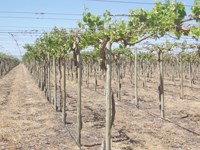Preserved wood vineyard poles, the best - Denise Conradie

Conradie was a guest speaker at a presentation at the University of Stellenbosch which was initiated by Marianne McKay, Oenology Lecturer at the University's Department of Oenology and Viticulture.
The disadvantages of using non-wood posts such as steel, concrete and composite trellising systems vary from damage to mechanical harvesters and lower load bearing capacity and failures such as bending due to prolonged high temperatures. The conclusion was that when a life cycle assessment of vineyard poles is followed to draw comparisons between alternative products, preserved wood holds its own if not out performs some of the other products.
Pressure treatment extends life-time
Importantly, from an environmental perspective Conradie added, wood has a low carbon footprint. Carbon dioxide is stored throughout the life of a wood product, ensuring the gas is sequestered from the atmosphere. Forests are thus highly efficient 'carbon sinks' while also being producers of oxygen.
The most sound treatment method for preserving timber to extend the life-time of the wood is still the pressure treatment of wood in a pressure vessel. During this procedure a vacuum is drawn to remove as much air as possible from the timber cells and then pressure is applied to ensure that the preservative is pushed as deep as possible into the cell's lumen.
Conradie touched on the international criteria for organic farming and acceptable organic practices. In South Africa the acceptable practice is that if a suitable approved product cannot be found, the organic farmers use what is available.
"Clearly treated wood posts are still the most preferred and cost effective cultivation solution in the national and international vineyard industry," she said.






























